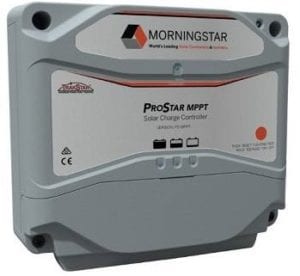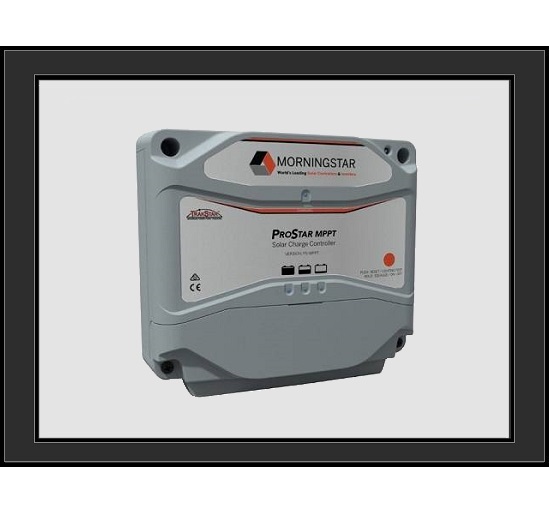The Heart of the System
The solar charge controller is the heart of any off-grid solar system and is critical to the health of the battery. Its main function is to prevent  the battery from being overcharged or undercharged. Proper charging of Valve Regulated Lead Acid (VRLA) batteries is very important to the life expectancy of the battery. If a VRLA battery is overcharged and it gasses, then the capacity is reduced; conversely, if the battery is undercharged sulfate crystals will form on the plates and reduce the capacity of the battery.
the battery from being overcharged or undercharged. Proper charging of Valve Regulated Lead Acid (VRLA) batteries is very important to the life expectancy of the battery. If a VRLA battery is overcharged and it gasses, then the capacity is reduced; conversely, if the battery is undercharged sulfate crystals will form on the plates and reduce the capacity of the battery.
The technology and type of charge controller is actually less important than the charge setpoints. (refer to SunWize’s tech note on Solar Charge Controller Types for more information) Charge setpoints are part of the cycle strategy designed to reduce the amount of time the storage bank spends at a low state of charge. They should be set per the recommendation of the battery manufacturer.
The battery has become one the most expensive components of off-grid systems. A good solar battery in a properly designed system can last 5-8 years; however, a good charge controller and proper setpoints are crucial elements in having such a long-last life expectancy.
The Primary Features
Proper Battery Charging
Indicator Lights
The Optional Features
Low Voltage Disconnect
Controllers can include a Low Voltage Disconnect (LVD) which disconnects the load from the battery in the event that the battery falls to a low state of charge. This feature can prevent the battery from being over-discharged, which can possibly cause permanent damage to the battery.
Adjustable Setpoints
Controllers can include adjustable setpoints. This can be helpful in trying to match the ideal charge settings to the battery. Depending on the controller, adjustments can be made via jumpers, trim pots, dipswitches, display, computer, etc.
Display
Controllers can also include a display. The display can show voltages and currents, status, and other information. Some displays can also be used to adjust settings.
Load Control
In addition to a LVD, some controllers can also include load control. This can be anything from time of day use, to lighting control. Some controllers have very sophisticated lighting control features including nighttime dimming and LED drivers.
Datalogging
Some controllers include datalogging. The datalogging can range from daily min, max, or averages, to everything every 5 minutes. Regardless of how much, or what type of datalogging a controller has, any datalogging can be help in troubleshooting and preventing system failures.
Remote Communications
Communications can range from a local serial connection for making setpoint adjustments, to remote monitoring and control via the internet. Some charge controllers can integrate with a central controller for coordinated charging algorithms. Ethernet connections allow you set up alarms that can automatically send E-mails or text messages upon fault conditions.
Real Time Clock
A RTC can be helpful for datalogging and time of day load control.
Secondary Battery Charger
Some charge controllers can charge a second battery. This is primarily used in RV and marine applications, where the controller can charge both the “house” and “starter” batteries.
Additional I/O
Some controllers may have additional input/output terminals that can be used for anything from alarms to generator control. Inputs can be used for intrusion detection, generator fault, low fuel, etc.
Conclusions
This is not an extensive list; solar charge controllers are coming out with new features and functions every year. You never want to lose sight of the primary function to properly charging a battery; this is by far the most important feature of charge controllers. Have a question? Chat with us through our chat box or call us at (866) 827-6527.


